Analysis of the LIF/Mie Ratio from Individual Droplets for Planar Droplet Sizing: Application to Gasoline Fuels and Their Mixtures with Ethanol
Abstract
1. Introduction
2. Experimental Setup
2.1. Microscopic and Macroscopic LIF/Mie Setup
2.2. Droplet Generator
2.3. Fuels and Tracers Investigated
2.4. Post-Processing Routine of the Droplet Measurements
3. Results
3.1. Spectral Fluorescence Characterization of the Dye
3.2. Microscopic and Macroscopic Droplet Measurements
3.2.1. LIF and Mie Signals of Toliso
3.2.2. Effects of Ethanol Admixture
3.2.3. Effects of Laser Fluence and Dye Concentration on the LIF/Mie Ratio
3.2.4. Effects of Liquid Temperature
4. Conclusions and Outlook
Author Contributions
Funding
Acknowledgments
Conflicts of Interest
References
- Koegl, M.; Hofbeck, B.; Will, S.; Zigan, L. Investigation of soot formation and oxidation of ethanol and butanol fuel blends in a DISI engine at different exhaust gas recirculation rates. Appl. Energy 2018, 209, 426–434. [Google Scholar] [CrossRef]
- Storch, M.; Zigan, L.; Wensing, M.; Will, S. Systematic Investigation of the Influence of Ethanol Blending on Sooting Combustion in DISI Engines Using High-Speed Imaging and LII. SAE Tech. Pap. 2014. [Google Scholar] [CrossRef]
- Chen, L.; Stone, R. Measurement of Enthalpies of Vaporization of Isooctane and Ethanol Blends and Their Effects on PM Emissions from a GDI Engine. Energy Fuels 2011, 25, 1254–1259. [Google Scholar] [CrossRef]
- Storch, M.; Hinrichsen, F.; Wensing, M.; Will, S.; Zigan, L. The effect of ethanol blending on mixture formation, combustion and soot emission studied in an optical DISI engine. Appl. Energy 2015, 156, 783–792. [Google Scholar] [CrossRef]
- Koegl, M.; Mishra, Y.N.; Storch, M.; Conrad, C.; Berrocal, E.; Will, S.; Zigan, L. Analysis of ethanol and butanol direct-injection spark-ignition sprays using two-phase structured laser illumination planar imaging droplet sizing. Int. J. Spray Combust. Dyn. 2019, 11, 16. [Google Scholar] [CrossRef]
- Le Gal, P.; Farrugia, N.; Greenhalgh, D.A. Laser Sheet Dropsizing of dense sprays. Opt. Laser Technol. 1999, 31, 75–83. [Google Scholar] [CrossRef]
- Domann, R.; Hardalupas, Y. Quantitative Measurement of Planar Droplet Sauter Mean Diameter in Sprays using Planar Droplet Sizing. Part. Part. Syst. Charact. 2003, 20, 209–218. [Google Scholar] [CrossRef]
- Domann, R.; Hardalupas, Y. Spatial distribution of fluorescence intensity within large droplets and its dependence on dye concentration. Appl. Opt. 2001, 40, 3586–3597. [Google Scholar] [CrossRef]
- Domann, R.; Hardalupas, Y. A Study of Parameters that Influence the Accuracy of the Planar Droplet Sizing (PDS) Technique. Part. Part. Syst. Charact. 2001, 18, 3–11. [Google Scholar] [CrossRef]
- Domann, R.; Hardalupas, Y.; Jones, A.R. A study of the influence of absorption on the spatial distribution of fluorescence intensity within large droplets using Mie theory, geometrical optics and imaging experiments. Meas. Sci. Tech. 2002, 13, 280–291. [Google Scholar] [CrossRef]
- Frackowiak, B.; Tropea, C. Fluorescence modeling of droplets intersecting a focused laser beam. Opt. Lett. 2010, 35, 1386–1388. [Google Scholar] [CrossRef] [PubMed]
- Frackowiak, B.; Tropea, C. Numerical analysis of diameter influence on droplet fluorescence. Appl. Opt. 2010, 49, 2363–2370. [Google Scholar] [CrossRef] [PubMed]
- Charalampous, G.; Hardalupas, Y. Method to reduce errors of droplet sizing based on the ratio of fluorescent and scattered light intensities (laser-induced fluorescence/Mie technique). Appl. Opt. 2011, 50, 3622–3637. [Google Scholar] [CrossRef] [PubMed]
- Charalampous, G.; Hardalupas, Y. Numerical evaluation of droplet sizing based on the ratio of fluorescent and scattered light intensities (LIF/Mie technique). Appl. Opt. 2011, 50, 1197–1209. [Google Scholar] [CrossRef]
- Koegl, M.; Hofbeck, B.; Baderschneider, K.; Mishra, Y.N.; Huber, F.J.T.; Berrocal, E.; Will, S.; Zigan, L. Analysis of LIF and Mie signals from single micrometric droplets for instantaneous droplet sizing in sprays. Opt. Express 2018, 26, 31750–31766. [Google Scholar] [CrossRef]
- Koegl, M.; Mishra, Y.N.; Hofbeck, B.; Baderschneider, K.; Huber, F.J.T.; Pracht, J.; Berrocal, E.; Will, S.; Zigan, L. 3D LIF/Mie planar droplet sizing in IC engine sprays using single-droplet calibration data. In Proceedings of the ICLASS 2018: 14th International Conference on Liquid Atomization & Spray Systems, Chicago IL, USA, 22–26 July 2018. [Google Scholar]
- Park, S.; Cho, H.; Yoon, I.; Min, K. Measurement of droplet size distribution of gasoline direct injection spray by droplet generator and planar image technique. Meas. Sci. Tech. 2002, 13, 859–864. [Google Scholar] [CrossRef]
- Zhao, H.; Ladommatos, N. Optical diagnostics for in-cylinder mixture formation measurements in IC engines. Prog. Energy Combust. Sci. 1998, 24, 297–336. [Google Scholar] [CrossRef]
- Wieske, P.; Wissel, S.; Grünefeld, G.; Pischinger, S. Improvement of LIEF by wavelength-resolved acquisition of multiple images using a single CCD detector—Simultaneous 2D measurement of air/fuel ratio, temperature distribution of the liquid phase and qualitative distribution of the liquid phase with the Multi-2D technique. Appl. Phys. B 2006, 83, 323. [Google Scholar] [CrossRef]
- Mishra, Y.N.; Kristensson, E.; Berrocal, E. Reliable LIF/Mie droplet sizing in sprays using structured laser illumination planar imaging. Opt. Express 2014, 22, 4480–4492. [Google Scholar] [CrossRef]
- Jermy, M.C.; Greenhalgh, D.A. Planar dropsizing by elastic and fluorescence scattering in sprays too dense for phase Doppler measurement. Appl. Phys. B 2000, 71, 703–710. [Google Scholar] [CrossRef]
- Mishra, Y.N.; Kristensson, E.; Koegl, M.; Jonsson, J.; Zigan, L.; Berrocal, E. Comparison between two-phase and one-phase SLIPI for instantaneous imaging of transient sprays. Exp. Fluids 2017, 58, 110. [Google Scholar] [CrossRef]
- Storch, M.; Mishra, Y.N.; Koegl, M.; Kristensson, E.; Will, S.; Zigan, L.; Berrocal, E. Two-phase SLIPI for instantaneous LIF and Mie imaging of transient fuel sprays. Opt. Lett. 2016, 41, 5422–5425. [Google Scholar] [CrossRef]
- Durst, A.; Wensing, M.; Berrocal, E. Light sheet fluorescence microscopic imaging for the primary breakup of diesel and gasoline sprays with real-world fuels. Appl. Opt. 2018, 57, 2704. [Google Scholar] [CrossRef] [PubMed]
- Mishra, Y.N.; Koegl, M.; Baderschneider, K.; Hofbeck, B.; Berrocal, E.; Conrad, C.; Will, S.; Zigan, L. 3D mapping of droplet Sauter mean diameter in sprays. Appl. Opt. 2019, 58, 3775–3783. [Google Scholar] [CrossRef] [PubMed]
- Depredurand, V.; Castanet, G.; Lemoine, F. Heat and mass transfer in evaporating droplets in interaction: Influence of the fuel. Int. J. Heat Mass Transf. 2010, 53, 3495–3502. [Google Scholar] [CrossRef]
- Depredurand, V.; Miron, P.; Labergue, A.; Wolff, M.; Castanet, G.; Lemoine, F. A temperature-sensitive tracer suitable for two-colour laser-induced fluorescence thermometry applied to evaporating fuel droplets. Meas. Sci. Tech. 2008, 19, 105403. [Google Scholar] [CrossRef]
- Koegl, M.; Mull, C.; Baderschneider, K.; Wislicenus, J.; Will, S.; Zigan, L. Characterization of Nile Red as a Tracer for Laser-Induced Fluorescence Spectroscopy of Gasoline and Kerosene and Their Mixture with Biofuels. Sensors 2019, 19, 2822. [Google Scholar] [CrossRef]
- Zhang, Y.; Leng, J.; Hu, W. Theoretical Design of a Two-Photon Fluorescent Probe for Nitric Oxide with Enhanced Emission Induced by Photoninduced Electron Transfer. Sensors 2018, 18, 1324. [Google Scholar] [CrossRef]
- Lin, B.S.; Yang, Y.C.; Ho, C.Y.; Yang, H.Y.; Wang, H.Y. A PDMS-based cylindrical hybrid lens for enhanced fluorescence detection in microfluidic systems. Sensors 2014, 14, 2967–2980. [Google Scholar] [CrossRef]
- Greenspan, P.; Fowler, S.D. Spectrofluorometric Studies of the Lipid Probe, Nile Red. J. Lipid Res. 1985, 26, 781–789. [Google Scholar]
- Storch, M.; Pfaffenberger, A.; Koegl, M.; Will, S.; Zigan, L. Combustion and Sooting Behavior of Spark-Ignited Ethanol–Isooctane Sprays under Stratified Charge Conditions. Energy Fuels 2016, 30, 6080–6090. [Google Scholar] [CrossRef]
- Koegl, M.; Hofbeck, B.; Will, S.; Zigan, L. Influence of EGR and ethanol blending on soot formation in a DISI engine. Proc. Combust. Inst. 2019, 37, 4965–4972. [Google Scholar] [CrossRef]
- MSP Corporation Announces a New Breakthrough in Monodisperse Droplet Generation. Available online: http://www.prweb.com/releases/2017/03/prweb14170934.htm (accessed on 24 July 2019).
- Li, H.; Rosebrock, C.D.; Wriedt, T.; Mädler, L. The effect of initial diameter on rainbow positions and temperature distributions of burning single-component n-Alkane droplets. J. Quant. Spectrosc. Radiat. Transf. 2017, 195, 164–175. [Google Scholar] [CrossRef]
- Storch, M.; Koegl, M.; Altenhoff, M.; Will, S.; Zigan, L. Investigation of soot formation of spark-ignited ethanol-blended gasoline sprays with single- and multi-component base fuels. Appl. Energy 2016, 181, 278–287. [Google Scholar] [CrossRef]
- Burri, J.; Crockett, R.; Hany, R.; Rentsch, D. Gasoline composition determined by 1H NMR spectroscopy. Fuel 2004, 83, 187–193. [Google Scholar] [CrossRef]
- Choi, B.C.; Choi, S.K.; Chung, S.H. Soot formation characteristics of gasoline surrogate fuels in counterflow diffusion flames. Proc. Combust. Inst. 2011, 33, 609–616. [Google Scholar] [CrossRef]
- Dean, J.A. Lange’s Handbook of Chemistry, 15th ed.; McGraw-Hill Companies: New York NY, USA, 1999. [Google Scholar]
- Bronkhorst FLUIDAT on the Net. Available online: https://www.fluidat.com (accessed on 24 September 2019).
- GmbH, R.B. Kraftfahrtechnisches Taschenbuch; Vieweg+Teubner Verlag: Wiesbaden, Germany, 2011. [Google Scholar]
- Wang, F.; Wu, J.; Liu, Z. Surface Tensions of Mixtures of Diesel Oil or Gasoline and Dimethoxymethane, Dimethyl Carbonate, or Ethanol. Energy Fuels 2006, 20, 2471–2474. [Google Scholar] [CrossRef]
- Luning Prak, D.J.; Cowart, J.S.; Trulove, P.C. Density, Viscosity, Speed of Sound, Bulk Modulus, and Surface Tension of Binary Mixtures of n-Heptane + 2,2,4-Trimethylpentane at (293.15 to 338.15) K and 0.1 MPa. J. Chem. Eng. Data 2014, 59, 3842–3851. [Google Scholar] [CrossRef]
- Kalathimekkad, S.; Missinne, J.; Schaubroeck, D.; Mandamparambil, R.; Van Steenberge, G. Alcohol Vapor Sensor Based on Fluorescent Dye-Doped Optical Waveguides. IEEE Sens. J. 2015, 15, 76–81. [Google Scholar] [CrossRef]
- Onofri, F.R.A.; Ren, K.F.; Sentis, M.; Gaubert, Q.; Pelcé, C. Experimental validation of the vectorial complex ray model on the inter-caustics scattering of oblate droplets. Opt. Express 2015, 23, 15768–15773. [Google Scholar] [CrossRef]
- Koban, W.; Koch, J.D.; Hanson, R.K.; Schulz, C. Absorption and fluorescence of toluene vapor at elevated temperatures. Phys. Chem. Chem. Phys. 2004, 6, 2940–2945. [Google Scholar] [CrossRef]
- Berrocal, E.; Kristensson, E.; Hottenbach, P.; Aldén, M.; Grünefeld, G. Quantitative imaging of a non-combusting diesel spray using structured laser illumination planar imaging. Appl. Phys. B. 2012, 109, 683–694. [Google Scholar] [CrossRef]
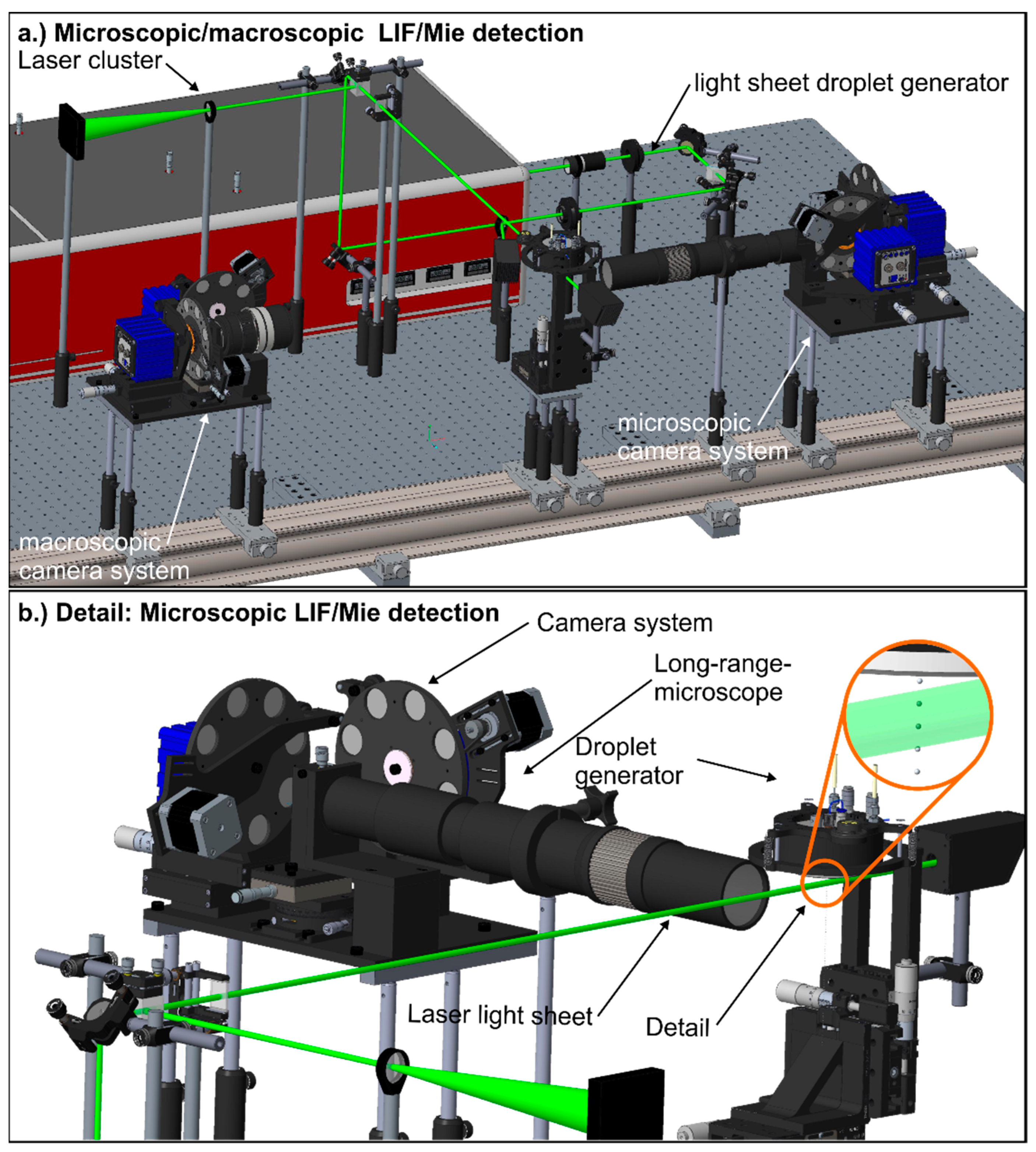

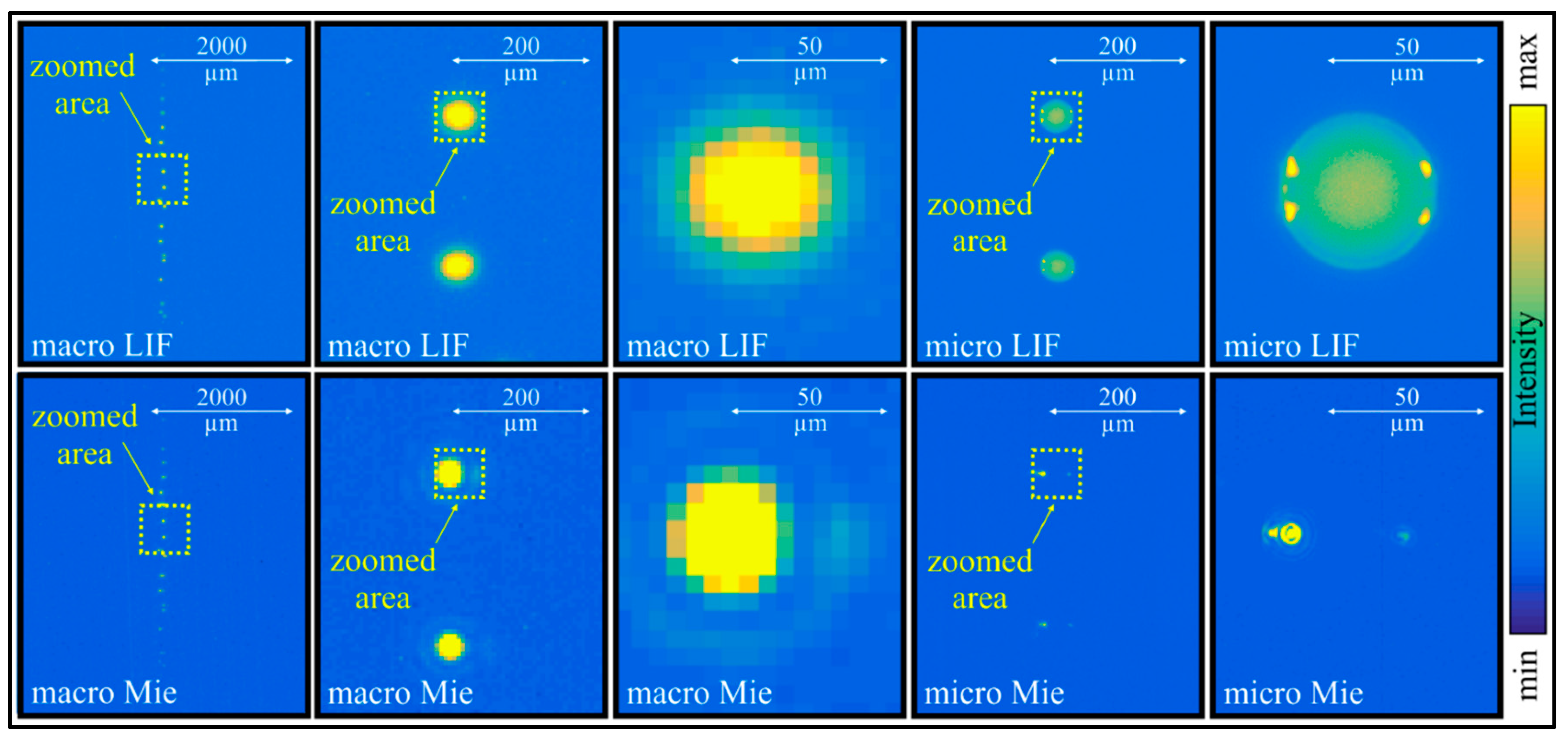
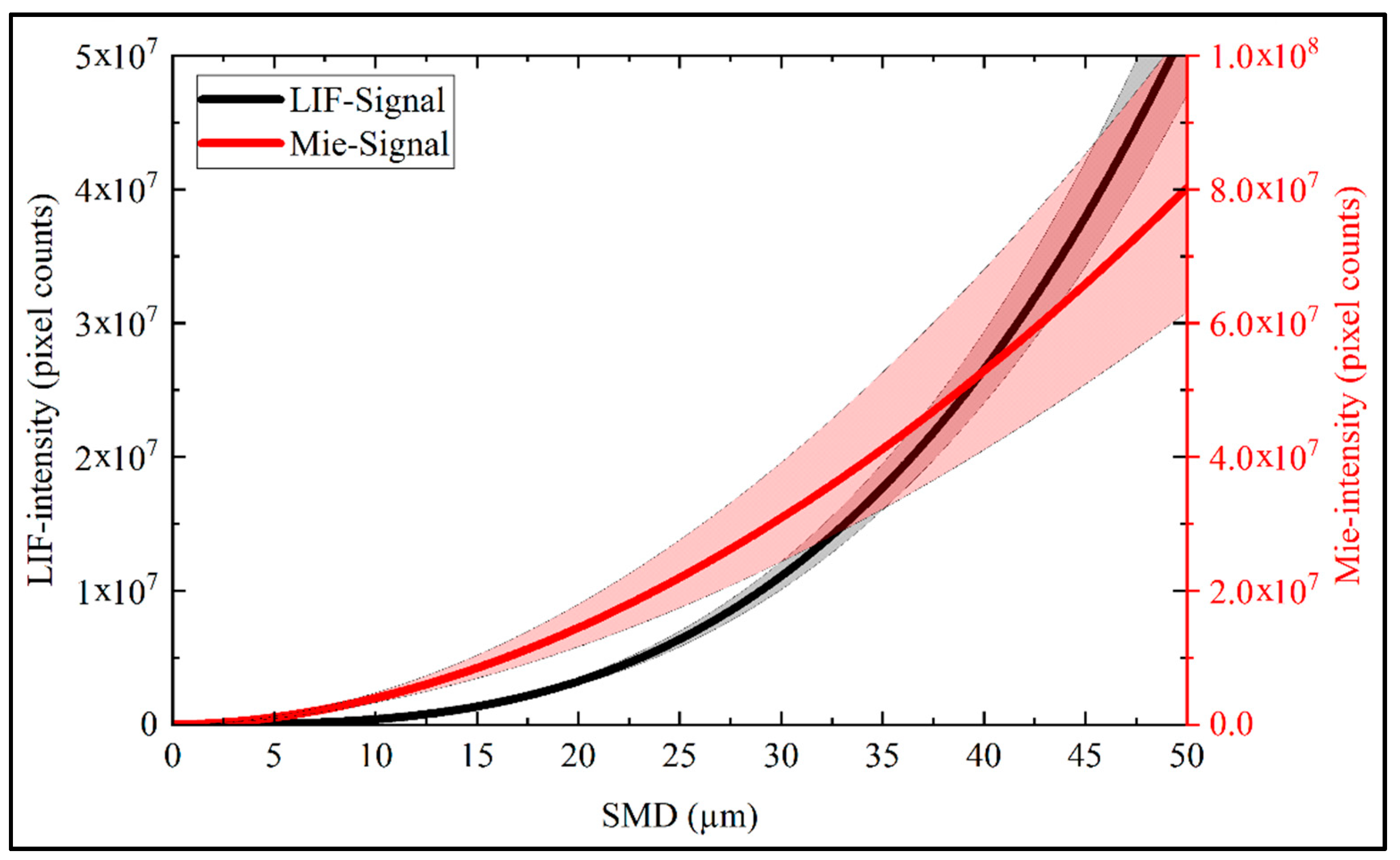
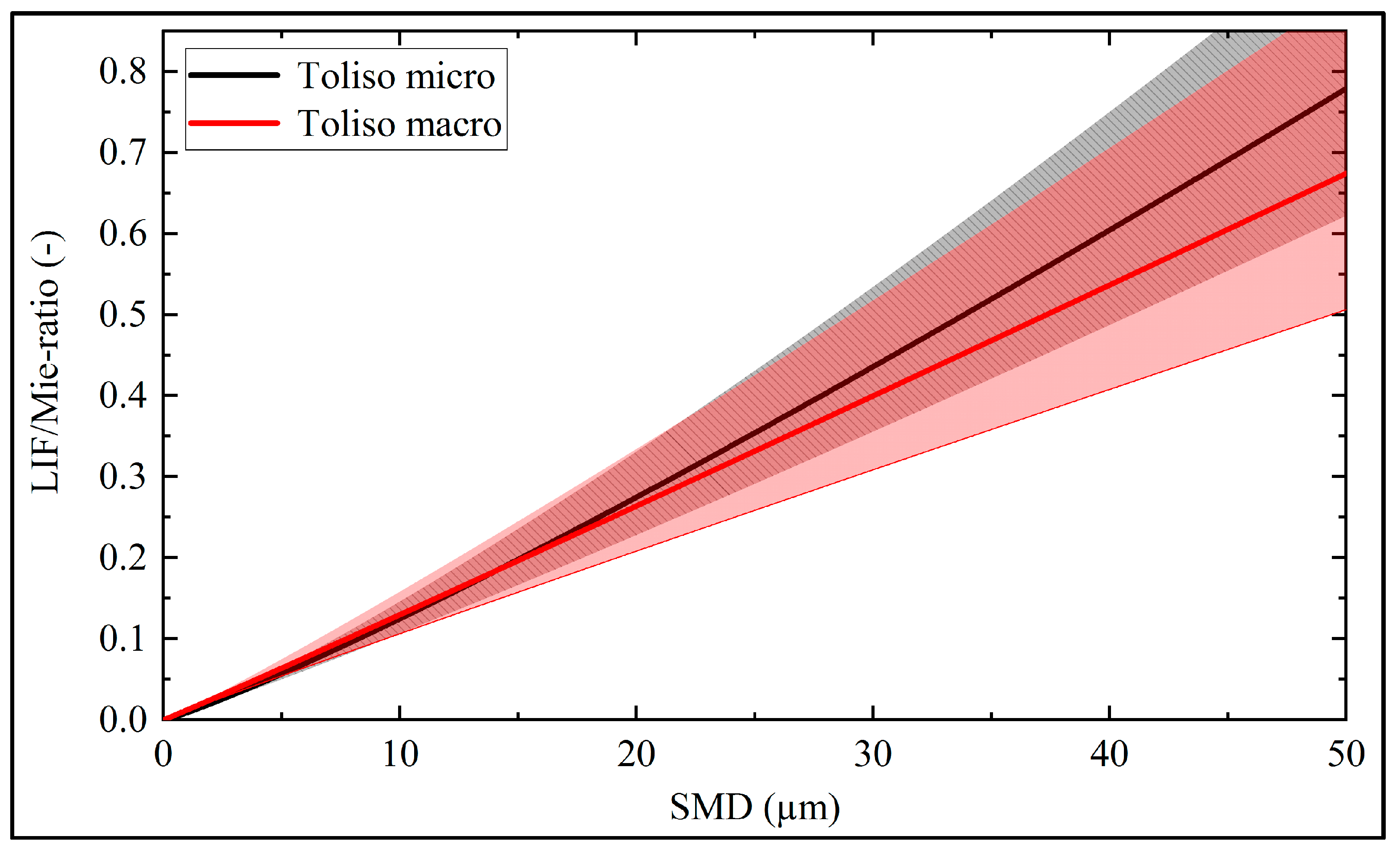


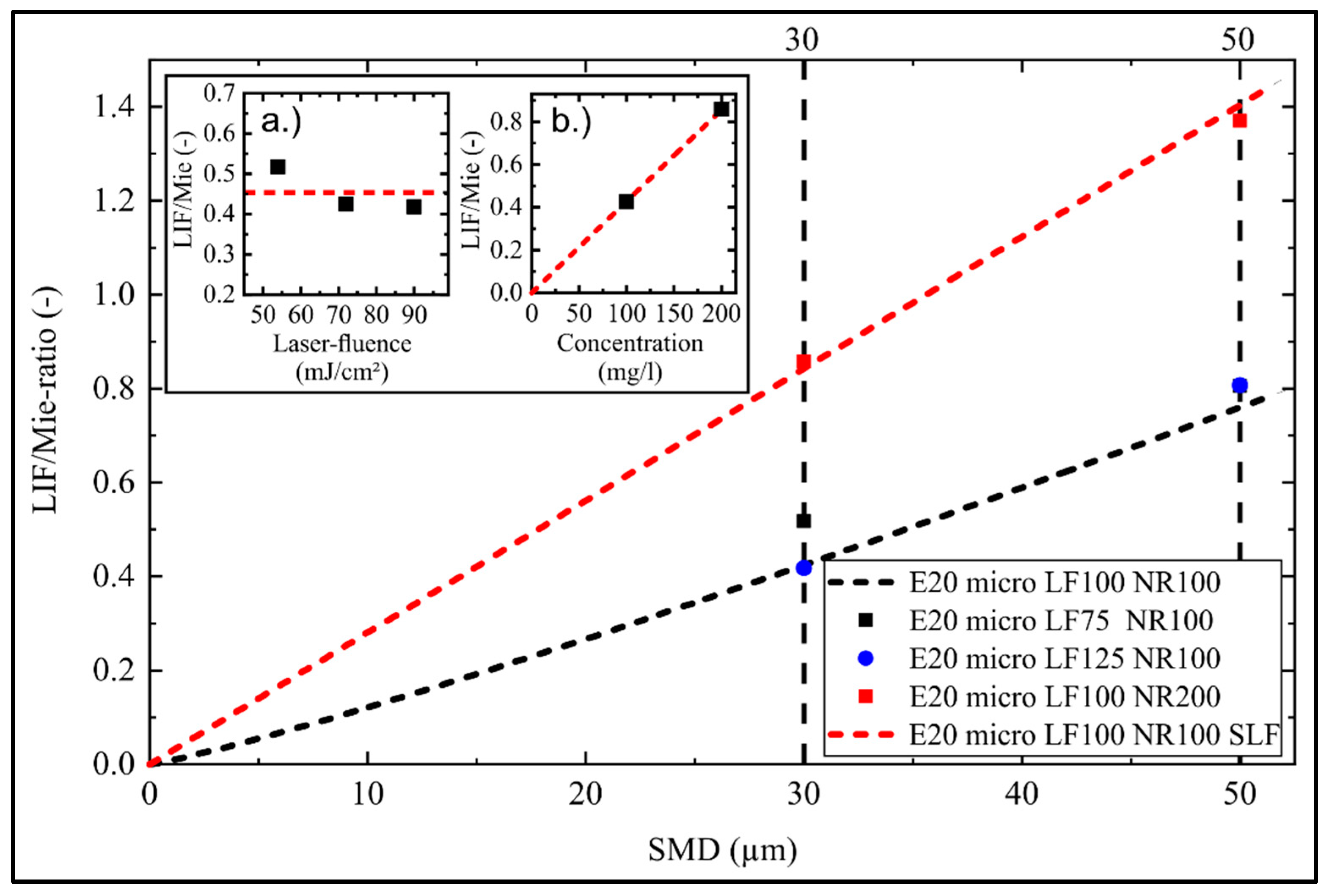
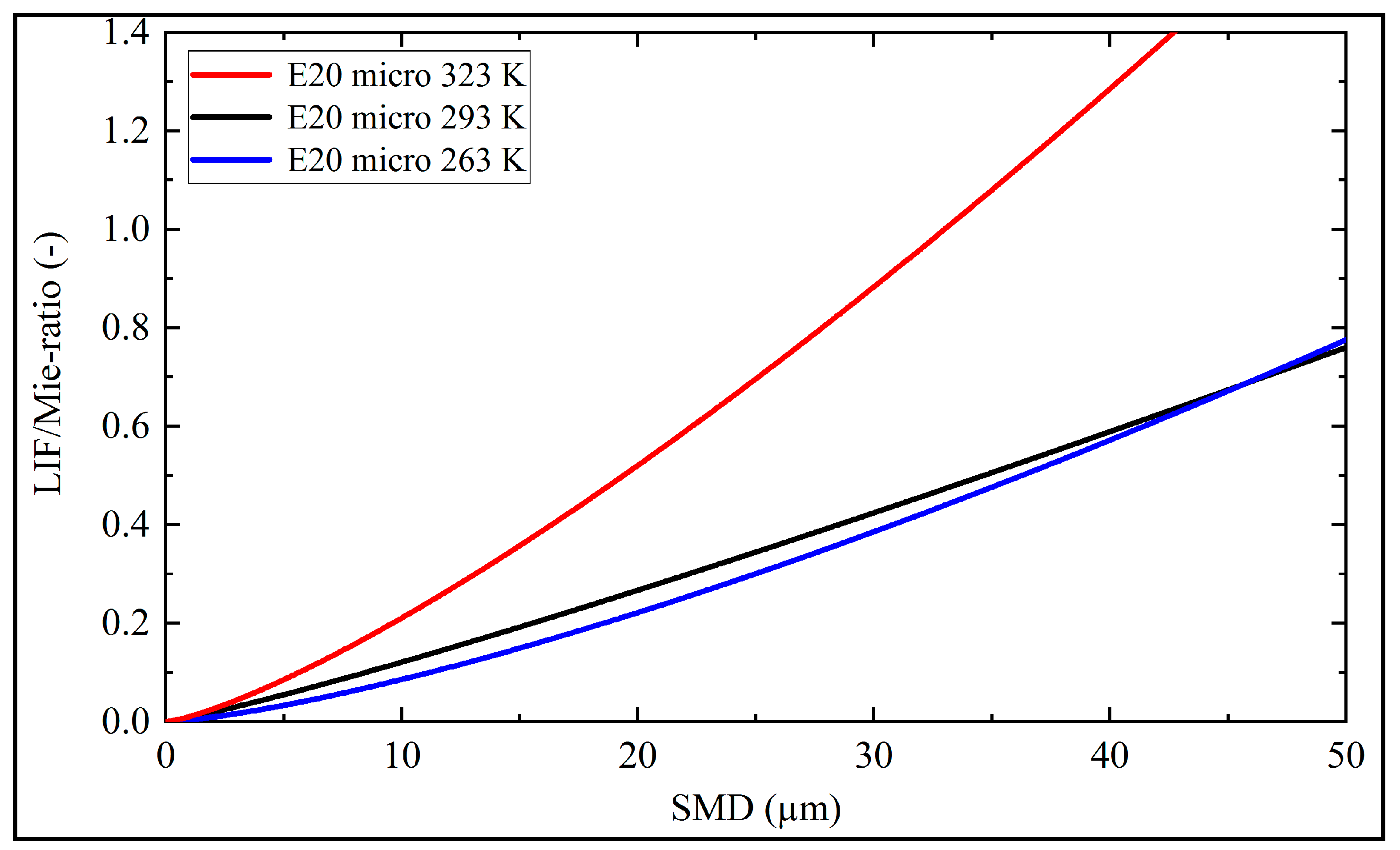
| Property | Unit | Isooctane | Toluene | Ethanol | Gasoline |
|---|---|---|---|---|---|
| H/C-ratio | - | 2.25 | 1.14 | 3 | - |
| Boiling point @ 0.1 MPa | K | 372 | 383 | 351 | 298–483 |
| Density @ 293 K, 0.1 MPa | g/cm3 | 0.69 | 0.87 | 0.79 | 0.72–0.78 |
| Dynamic viscosity @ 0.1 MPa, 293 K | mPa s | 0.501 | 0.587 | 1.145 | 0.6 |
| Surface tension @ 293 K | N/m | 0.0188 | 0.0285 | 0.0224 | 0.0216 |
| Heat of vaporization @ 293 K | kJ/kg | 305.4 | 409.3 | 938.2 | 380–500 |
| Stoichiometric air-fuel ratio | kg/kg | 15.2 | 13.4 | 9.0 | 14.7 |
| Lower Heating Value | MJ/kg | 44.6 | 40.6 | 26.8 | 40.1–41.6 |
© 2019 by the authors. Licensee MDPI, Basel, Switzerland. This article is an open access article distributed under the terms and conditions of the Creative Commons Attribution (CC BY) license (http://creativecommons.org/licenses/by/4.0/).
Share and Cite
Koegl, M.; Baderschneider, K.; Bauer, F.J.; Hofbeck, B.; Berrocal, E.; Will, S.; Zigan, L. Analysis of the LIF/Mie Ratio from Individual Droplets for Planar Droplet Sizing: Application to Gasoline Fuels and Their Mixtures with Ethanol. Appl. Sci. 2019, 9, 4900. https://doi.org/10.3390/app9224900
Koegl M, Baderschneider K, Bauer FJ, Hofbeck B, Berrocal E, Will S, Zigan L. Analysis of the LIF/Mie Ratio from Individual Droplets for Planar Droplet Sizing: Application to Gasoline Fuels and Their Mixtures with Ethanol. Applied Sciences. 2019; 9(22):4900. https://doi.org/10.3390/app9224900
Chicago/Turabian StyleKoegl, Matthias, Kevin Baderschneider, Florian J. Bauer, Bernhard Hofbeck, Edouard Berrocal, Stefan Will, and Lars Zigan. 2019. "Analysis of the LIF/Mie Ratio from Individual Droplets for Planar Droplet Sizing: Application to Gasoline Fuels and Their Mixtures with Ethanol" Applied Sciences 9, no. 22: 4900. https://doi.org/10.3390/app9224900
APA StyleKoegl, M., Baderschneider, K., Bauer, F. J., Hofbeck, B., Berrocal, E., Will, S., & Zigan, L. (2019). Analysis of the LIF/Mie Ratio from Individual Droplets for Planar Droplet Sizing: Application to Gasoline Fuels and Their Mixtures with Ethanol. Applied Sciences, 9(22), 4900. https://doi.org/10.3390/app9224900





